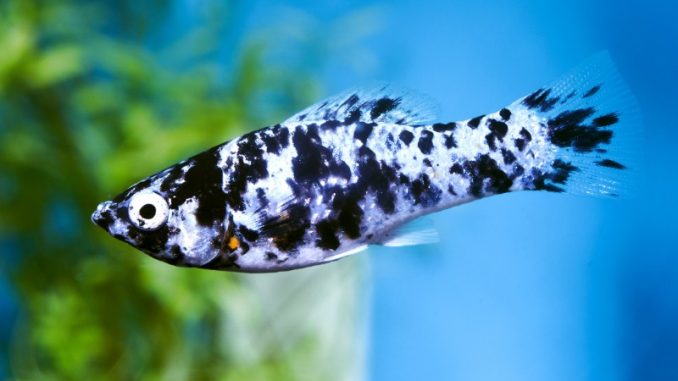
Molly fish, also known as mollies, are a type of freshwater fish that comes from the Poecilia genus in the Poeciliidae family. The fish are found in North and South America in shallow surface waters.
Molly fish are commonly found in home aquariums because they are easy to care for. Different types of molly fish display different colors, but all molly fish have a calm and peaceful nature.
The most popular types of molly fish can be sorted into three major categories: natural molly fish, selectively-bred sailfin molly fish, and selectively-bred lyretail molly fish.
TABLE OF CONTENTS
Natural Molly Fish
These types of molly fish appear abundantly in the wild. Natural molly fish that are kept in aquariums share the same coloring as their wild counterparts.
Shortfin Molly/Common Molly
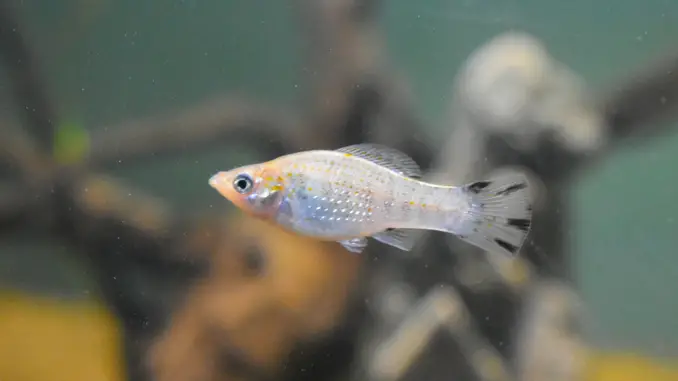
| Care level: | Temperament: | Color: | Lifespan: | Size: |
| Easy | Peaceful | Dull silver-gray | 3–5 years | 2–3 inches |
| Water temperature: | Water pH: | Tank size: | Diet: | Scientific name: |
| 70–82°F | 7.0–8.5 | 20 gallons | Omnivore | Poecilia sphenops |
The wild shortfin molly, also known as the common molly, is usually found in shallow freshwater systems but is sometimes found in brackish coastal waters. Common molly fish are a dull silver-gray. The male common molly is usually smaller with brighter color variations.
The common molly is a hardy and adaptable fish that enjoys aquarium setups with plenty of live plants and vegetation, along with enough shelter to hide in. To help prevent common diseases, add a teaspoon of aquarium salt to the tank water.
Common molly fish are active breeders, and when kept in a community tank, females should outnumber males at a 3:1 ratio. Feeding common mollies is simple, as they are omnivorous and eat algae-based flakes, veggies, mosquito larvae, and bloodworms (live or freeze-dried).
Sailfin Molly
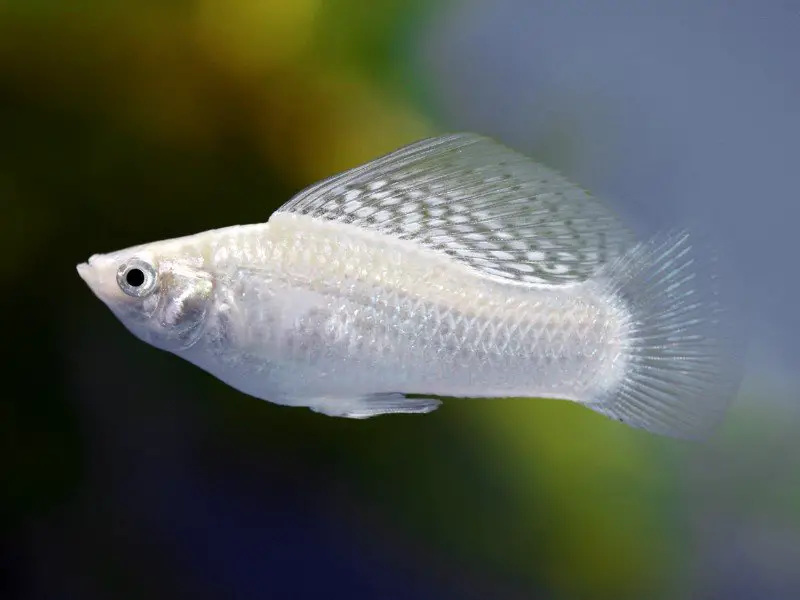
| Care level: | Temperament: | Color: | Lifespan: | Size: |
| Easy | Peaceful | Various | 1–5 years | 4–5 inches |
| Water temperature: | Water pH: | Tank size: | Diet: | Scientific name: |
| 68–82°F | 7.0–8.5 | 30 gallons | Omnivore | Poecilia latipinna |
The sailfin molly fish is a popular group of molly fish, and many subspecies have been aquarium-bred from this fish. Sailfin molly fish appear in a variety of colors and can be identified by the male’s large dorsal fin that looks like a sail on a boat.
Like other freshwater fish, sailfin molly fish are easy to care for as long as the water is kept within the right parameters. The aquarium should be densely vegetated with live plants while keeping enough open areas for the fish to swim around. 50% of the tank water should be changed each week.
Molly fish are active breeders, and while they can be kept in a tank with other molly species, they are likely to crossbreed.
Yucatan Lyretail Molly
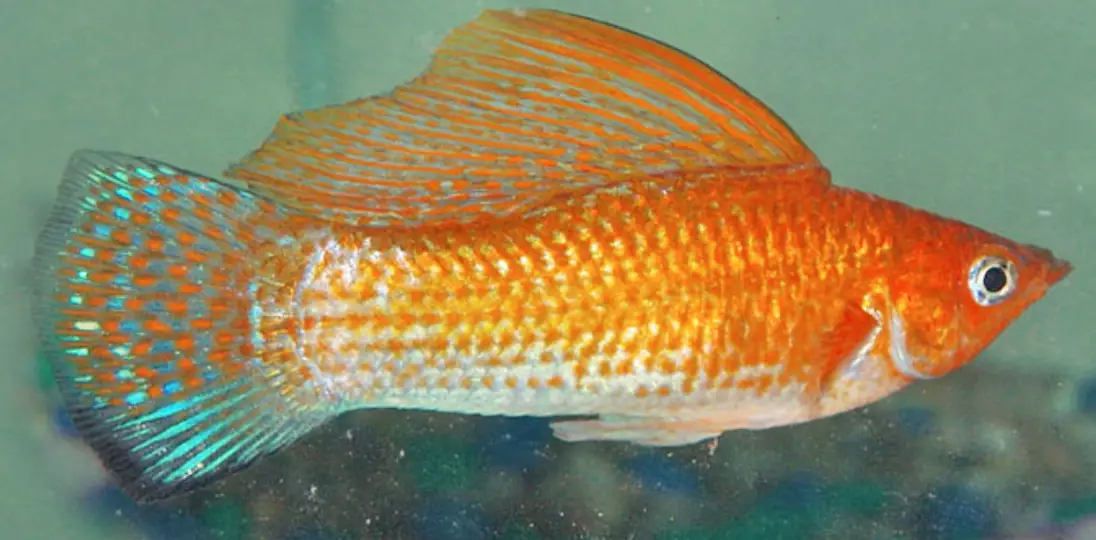
| Care level: | Temperament: | Color: | Lifespan: | Size: |
| Easy | Peaceful | Silver, tan, or various bright colors | 3–8 years | 5–7 inches |
| Water temperature: | Water pH: | Tank size: | Diet: | Scientific name: |
| 77–83°F | 7.0–8.5 | 40 gallons | Omnivore | Poecilia velifera |
The Yucatan molly fish, also known as the giant sailfin molly, looks similar to the common sailfin molly. However, the Yucatan molly is longer and larger. Also, compared to sailfin mollies, male Yucatan molly fish have a bigger dorsal fin with six extra rays on the fin.
Wild Yucatan molly fish are silver, dull gray, or tan, while captive-bred varieties have other bright colorings.
Yucatan molly fish need warmer temperatures than other types of mollies, and the water temperature should be carefully monitored. Tank heaters should be added to the tank during the colder months to regulate the water temperature.
While Yucatan molly fish are peaceful, they may bully smaller fish, especially during the breeding season. Yucatan molly fish are not shy and will be seen swimming around often. To prevent the males from tiring out the female fish, always keep more female Yucatan molly fish in a tank than males.
Liberty Molly

| Care level: | Temperament: | Color: | Lifespan: | Size: |
| Moderate | Semi-aggressive | Silver and yellow or orange | 3–5 years | 2–3 inches |
| Water temperature: | Water pH: | Tank size: | Diet: | Scientific name: |
| 68–82°F | 7.0–8.0 | 30 gallons | Omnivore | Poecilia salvatoris |
The liberty molly fish is smaller than the common molly and tends to become slightly aggressive toward other fish. The liberty molly has a silver body with yellow and blue specks and rusty-red fins.
The tank conditions are not as strict for liberty molly fish because they’re a hardier species than other types of mollies. The liberty molly should be fed twice a day with a diet consisting of blanched vegetables, algae-based plants, and occasionally small amounts of raw meat.
Unlike other molly fish, the liberty molly is a fin nipper and should be kept away from fish with large fins. Liberty molly fish can be housed with other small-finned and fast fish.
Dwarf Molly
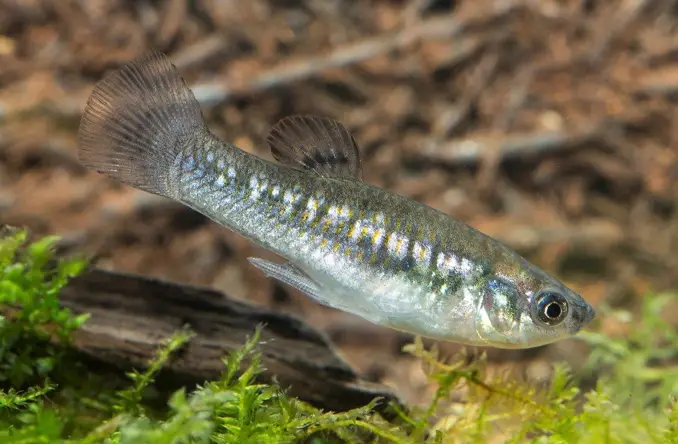
| Care level: | Temperament: | Color: | Lifespan: | Size: |
| Easy | Peaceful | Dark silver-gray or various colors | 3–5 years | 1.5–2 inches |
| Water temperature: | Water pH: | Tank size: | Diet: | Scientific name: |
| 72–82°F | 6.5–7.5 | 15 gallons | Omnivore | Poecilia chica |
Dwarf molly fish are similar to shortfin molly fish, but they’re smaller, reaching up to only 2 inches. Male dwarf molly fish are slightly larger than females, which are usually about 1.5 inches.
The dwarf molly fish has a smaller dorsal fin than other molly fish types. Wild dwarf molly fish are silver-gray but have been bred into a wide variety of colors.
In a tank setup, dwarf molly fish need less space than other molly types. A single dwarf molly needs a 15-gallon tank. The dwarf molly fish is easy to care for and will be happy with live plants, space to swim, and sheltered areas.
Certain wild molly fish come from environments with brackish water, in which case aquarium salt can help mimic the natural habitat. However, since most molly fish are aquarium-bred, they will survive in freshwater tank setups.
Selectively-bred Sailfin Molly Fish
Sailfin molly fish are known for the males’ enlarged dorsal fins, which are also called sailfins. While females tend to be more plainly colored than males, both females and males are selectively bred for their interesting coloring.
Common Black Molly

| Care level: | Temperament: | Color: | Lifespan: | Size: |
| Easy | Peaceful | Black | 2–5 years | 3 inches |
| Water temperature: | Water pH: | Tank size: | Diet: | Scientific name: |
| 68–82°F | 7.0–7.8 | 30 gallons | Omnivore | Poecilia sphenops |
The common black molly is a popular tank-bred molly similar to the common molly but covered in black scales. Some black molly fish have spots of silver or orange on their body, but this is rare.
The black molly prefers a large tank filled with carefully monitored freshwater. Your tank setup should include live plants for the black molly to graze on and open areas to swim, along with shelter and a light source.
The common black molly feeds on brine shrimp, algae flakes, vegetable flakes, and freeze-dried bloodworms. Black molly fish can be kept with other types of molly fish, but females should outnumber males in the tank at a 3:1 ratio.
The black molly is a good choice for beginners because it is hardy and easy to care for.
Balloon Belly Molly

| Care level: | Temperament: | Color: | Lifespan: | Size: |
| Moderate | Peaceful | Various | 1.5–2 years | 3 inches |
| Water temperature: | Water pH: | Tank size: | Diet: | Scientific name: |
| 68–82°F | 7.0–7.8 | 20–30 gallons | Omnivore | Poecilia latipinna |
The balloon belly molly fish is a captive-bred hybrid type of molly that is well-known for its rounded belly and arched back. Balloon belly molly fish are found in various combinations of yellow, black, orange, and silver-white.
Balloon belly molly fish should be kept in large tanks with the correct water conditions. The tank setup should also contain plenty of live plants for the fish to nibble on.
It is not known whether balloon belly molly fish are in pain because of the unnatural curve in their backs and bellies. Due to these abnormal features, balloon belly fish may develop fatal diseases more easily and have a shorter lifespan than other molly fish.
Black Sailfin Molly
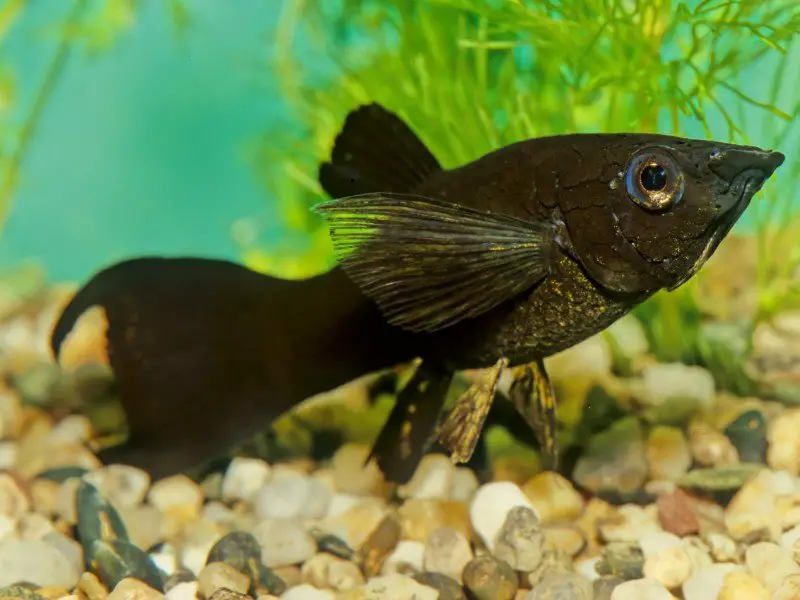
| Care level: | Temperament: | Color: | Lifespan: | Size: |
| Easy | Peaceful | Black | 3–5 years | 4 inches |
| Water temperature: | Water pH: | Tank size: | Diet: | Scientific name: |
| 68–82°F | 7.0–8.0 | 30 gallons | Omnivore | Poecilia latipinna |
The black sailfin molly fish, with long flowing fins, is darker than the common black molly. As long as the water conditions remain stable, the black sailfin molly fish is suitable for beginners because of its hardy nature.
Black sailfin molly fish need a large tank with live plants and space to swim. Add shelters to the tank to give a black sailfin molly fish plenty of space to explore.
While the black sailfin molly fish has a peaceful nature, it should not be housed with biting fish, as the sailfin’s fins will become a target. Add a tank heater and keep the water oxygenated to keep the black sailfin molly happy and healthy.
Dalmatian Molly
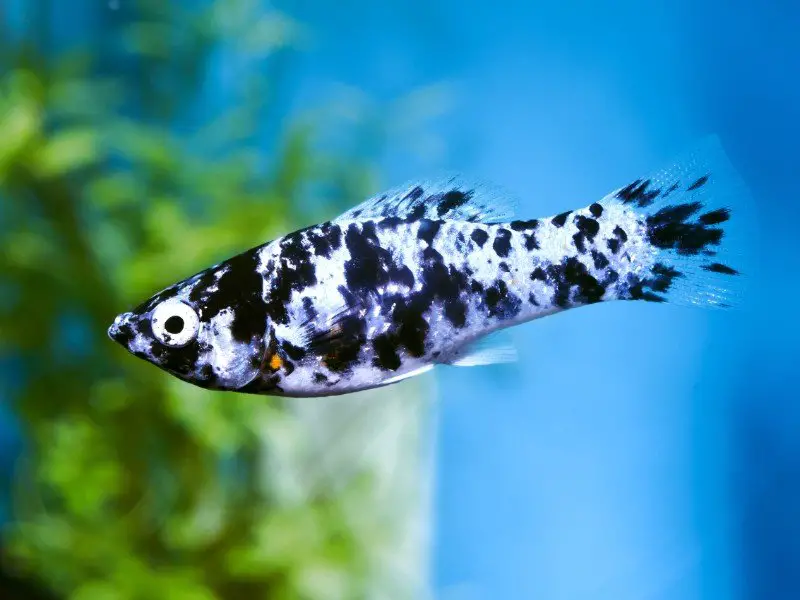
| Care level: | Temperament: | Color: | Lifespan: | Size: |
| Easy | Peaceful | Black and white | 3–5 years | 4–5 inches |
| Water temperature: | Water pH: | Tank size: | Diet: | Scientific name: |
| 68–82°F | 7.0–7.8 | 20–30 gallons | Omnivore | Poecilia latipinna |
The dalmatian molly is covered in an interesting black-and-white pattern, like that of a dalmatian dog. This type of molly fish is popular because of the different varieties of patterns on its body and fins.
A tank set up for a dalmatian molly fish should contain a gravel substrate, open space for swimming, and plenty of live plants and shelters. Dalmatian molly fish are omnivorous but should be fed plenty of vegetable-based flakes with a few bloodworms and brine shrimp.
Unlike common molly fish, male dalmatian molly fish are slightly larger than females. Dalmatian molly fish can easily get a disease known as shimmies which causes them to shake. To help prevent common diseases, add a teaspoon of aquarium salt to the tank water.
Harlequin Sailfin Molly
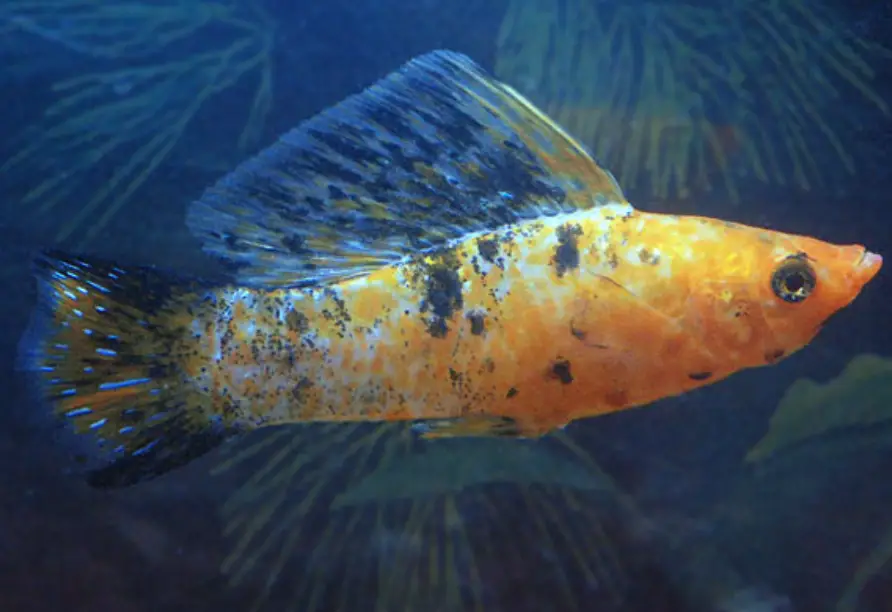
| Care level: | Temperament: | Color: | Lifespan: | Size: |
| Easy | Peaceful | Gold, white, and black | 3–5 years | 6 inches |
| Water temperature: | Water pH: | Tank size: | Diet: | Scientific name: |
| 68–82°F | 7.0–8.0 | 30 gallons | Omnivore | Poecilia latipinna |
The harlequin sailfin molly fish can grow up to 6 inches, much larger than the common molly. The body of the harlequin sailfin molly is white with black patches and specks of gold.
The tank setup for the harlequin sailfin should leave plenty of open areas for the fish to swim around. The tank should also contain live plants anchored into gravel substrate as well as driftwood and caves around the bottom.
The harlequin sailfin molly is peaceful and can live together with other peaceful species. Make sure to feed harlequin sailfin molly fish twice a day. If the harlequin sailfin molly doesn’t get enough food, it will start eating the live plants in the tank.
Selectively-bred Lyretail Molly Fish
Lyretail molly fish have tail fins shaped like a lyre, with elongated tips. Lyretail mollies are selectively bred not only for their unique coloring but also for their beautiful tail fin shape.
Dalmation Lyretail Molly
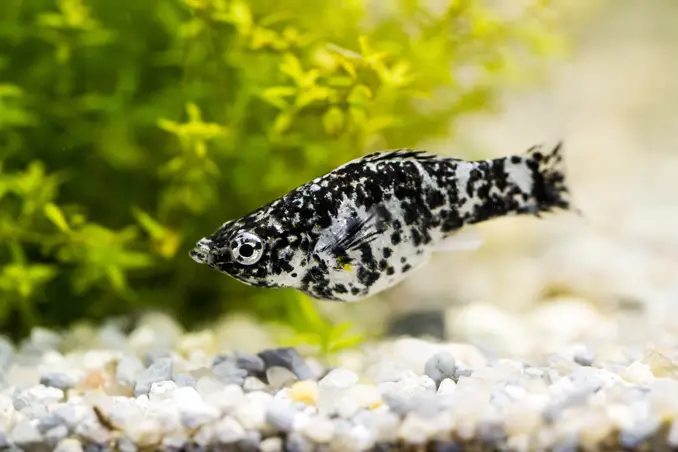
| Care level: | Temperament: | Color: | Lifespan: | Size: |
| Easy | Mostly peaceful | Marbled white and black | 3–5 years | 3 inches |
| Water temperature: | Water pH: | Tank size: | Diet: | Scientific name: |
| 68–82°F | 7.0–7.8 | 30 gallons | Omnivore | Poecilia latipinna |
The dalmatian lyretail molly is a hybrid variety of the dalmatian sailfin molly fish. The dalmatian lyretail molly is popular with aquarists because of its marbled color variations.
The tank setup for the dalmatian lyretail molly is the same as other molly types. Ensure it contains plenty of live plants. To keep the fish healthy, the water should remain within the correct parameters.
The dalmatian lyretail molly is whiter and slightly smaller than the regular dalmatian molly. Dalmatian lyretail molly fish are peaceful until provoked and can be kept in the same tank as other peaceful fish. The number of female molly fish should always outnumber males in the tank.
Black Lyretail Molly
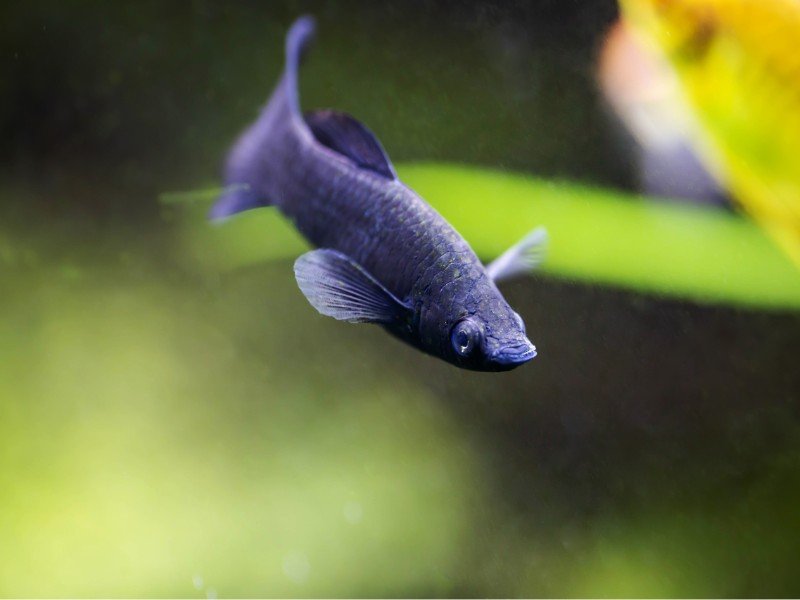
| Care level: | Temperament: | Color: | Lifespan: | Size: |
| Easy | Mostly peaceful | Black | 3–5 years | 5 inches |
| Water temperature: | Water pH: | Tank size: | Diet: | Scientific name: |
| 68–82°F | 7.0–8.0 | 30 gallons | Omnivore | Poecilia latipinna |
The black lyretail molly is a larger hybrid variation of the black sailfin molly. The fish is black with specks of white on its fins.
Although the black lyretail molly is a hardy species, the water conditions should remain stable to keep the fish healthy. The tank setup should contain plenty of live plants and may contain other peaceful tank mates.
The black lyretail molly requires a proper filtration system because of its healthy appetite and high waste production.
Creamsicle Lyretail Molly
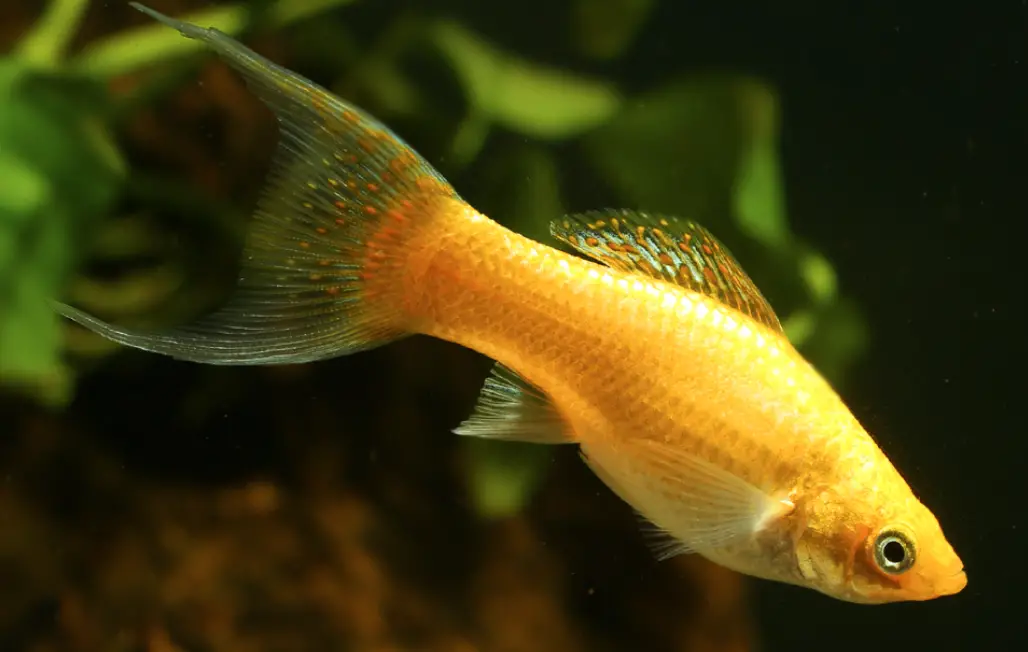
| Care level: | Temperament: | Color: | Lifespan: | Size: |
| Easy | Peaceful | Orange and white | 3–5 years | 3 inches |
| Water temperature: | Water pH: | Tank size: | Diet: | Scientific name: |
| 72–82°F | 7.0–7.8 | 20 gallons | Omnivore | Poecilia sphenops |
The creamsicle lyretail is a small type of molly fish with orange and white scales and vibrant orange spots on transparent fins.
This brightly colored molly fish needs a planted tank that includes plenty of shelters. Creamsicle lyretail molly fish should have a diet rich in fresh plant food with some raw meat at times.
Creamsicle lyretail molly fish can be housed with other molly species and peaceful fish. When breeding creamsicle lyretail fish, the female will give birth to live swimming fish that are often eaten by adult fish.
Marble Lyretail Molly
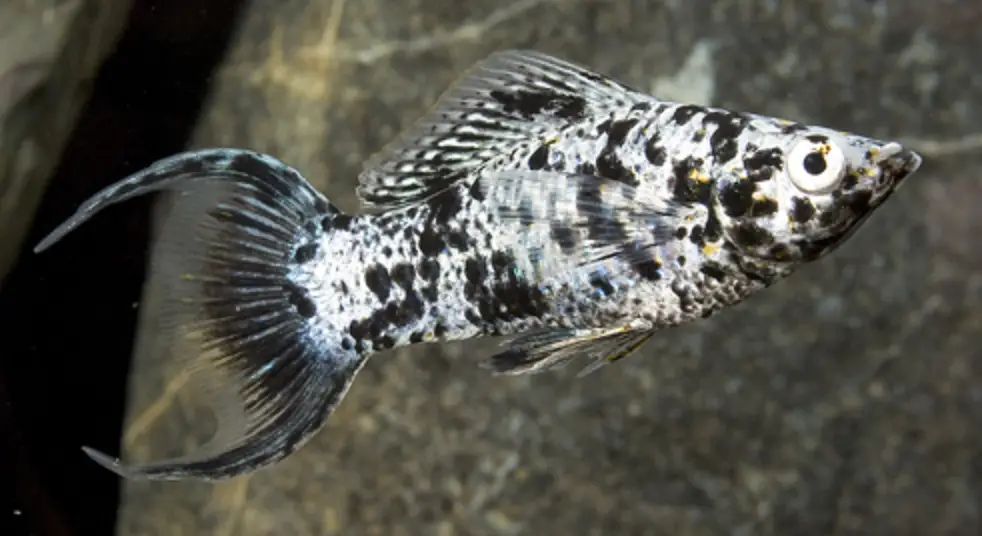
| Care level: | Temperament: | Color: | Lifespan: | Size: |
| Easy | Peaceful | Black and white, with gold or orange patches | 3–5 years | 3–5 inches |
| Water temperature: | Water pH: | Tank size: | Diet: | Scientific name: |
| 68–82°F | 7.0–8.0 | 30 gallons | Omnivore | Poecilia sphenops |
The marble lyretail molly is a popular molly fish because of its marbled coloring made up of black and white patches with splashes of orange. The male marble lyretail molly has a larger dorsal fin and a pointed anal fin compared to the female.
Beginner aquarists enjoy keeping this low-maintenance molly fish because of its hardy nature. The marble lyretail molly should have a freshwater tank no smaller than 30 gallons for one fish. The tank should contain live plants and enough place for the marble lyretail molly to swim around.
The marble lyretail molly is omnivorous and should be fed a plant-rich diet with occasional meaty additions including brine shrimp and bloodworms. Add a teaspoon of aquarium salt to a freshwater tank to keep the marble lyretail molly healthy.
Choosing & Caring For Different Types of Molly Fish
Molly fish are common aquarium pets and are well suited for beginner aquarists. Caring for molly fish is easy as long as you keep the tank water within the correct parameters. Most tanks should be at least 30 gallons with a pH level between 7.0–8.5 and a temperature between 72–82°F.
If you have aggressive fish in your tank, then a molly fish should not be added to the tank. Sailfin and lyretail molly fish should not live with other fish that tend to nip fins because these molly fish are likely to be hurt due to their long fins.
Different types of molly fish can live together, although they are likely to crossbreed. The female molly fish in a tank should always outnumber the males by 3:1 to prevent the males from tiring out the females during the breeding season.
The various colors and shapes of molly fish, as well as their active nature, will surely add life to your tank.

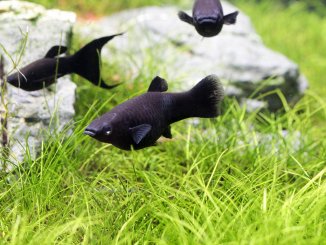
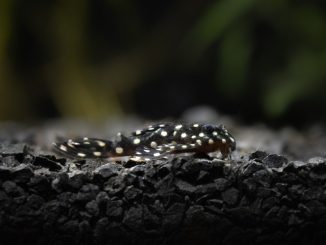
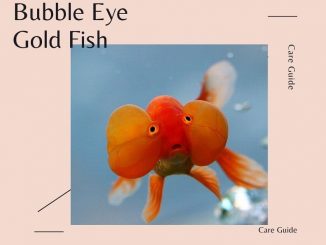
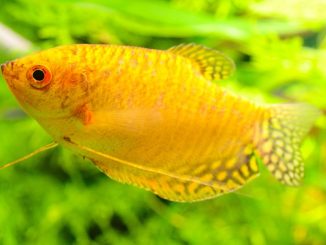
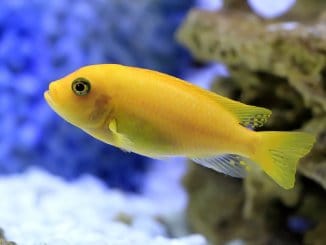
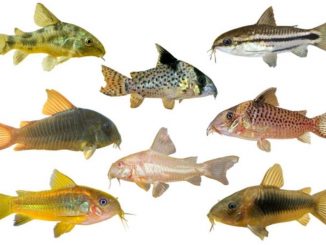
Be the first to comment